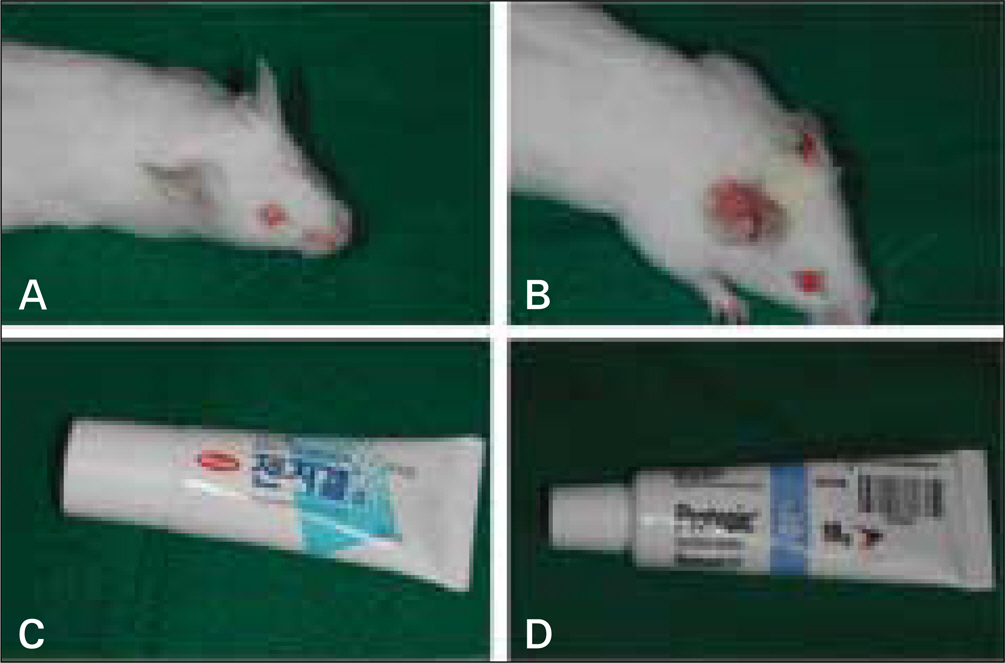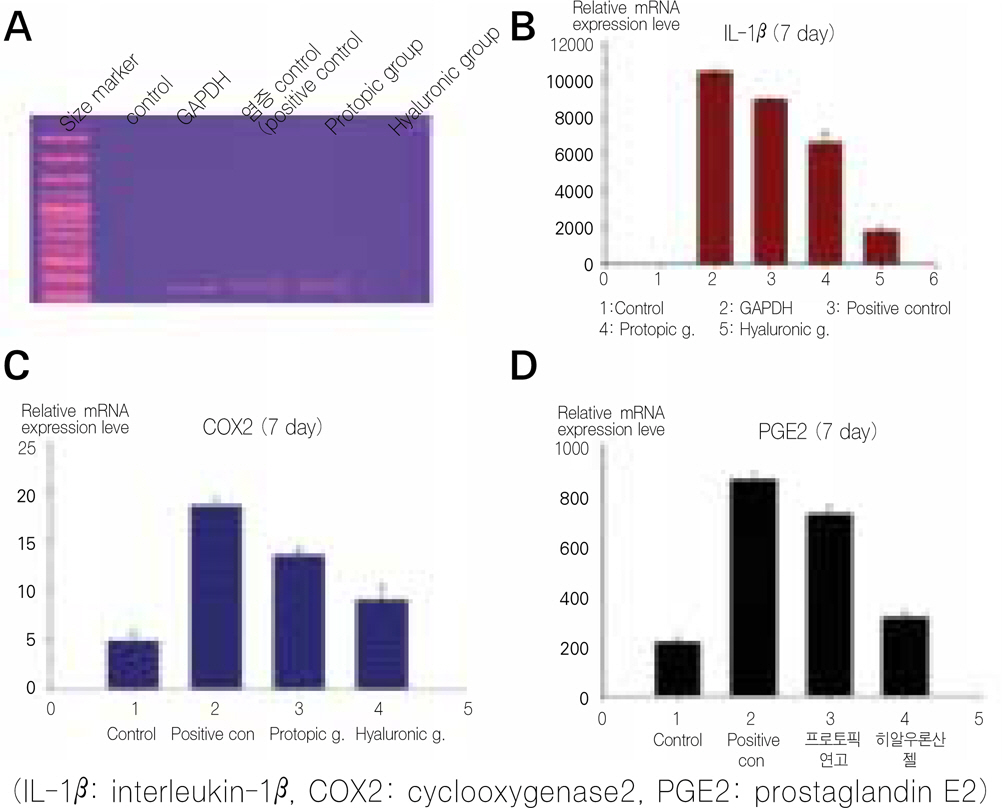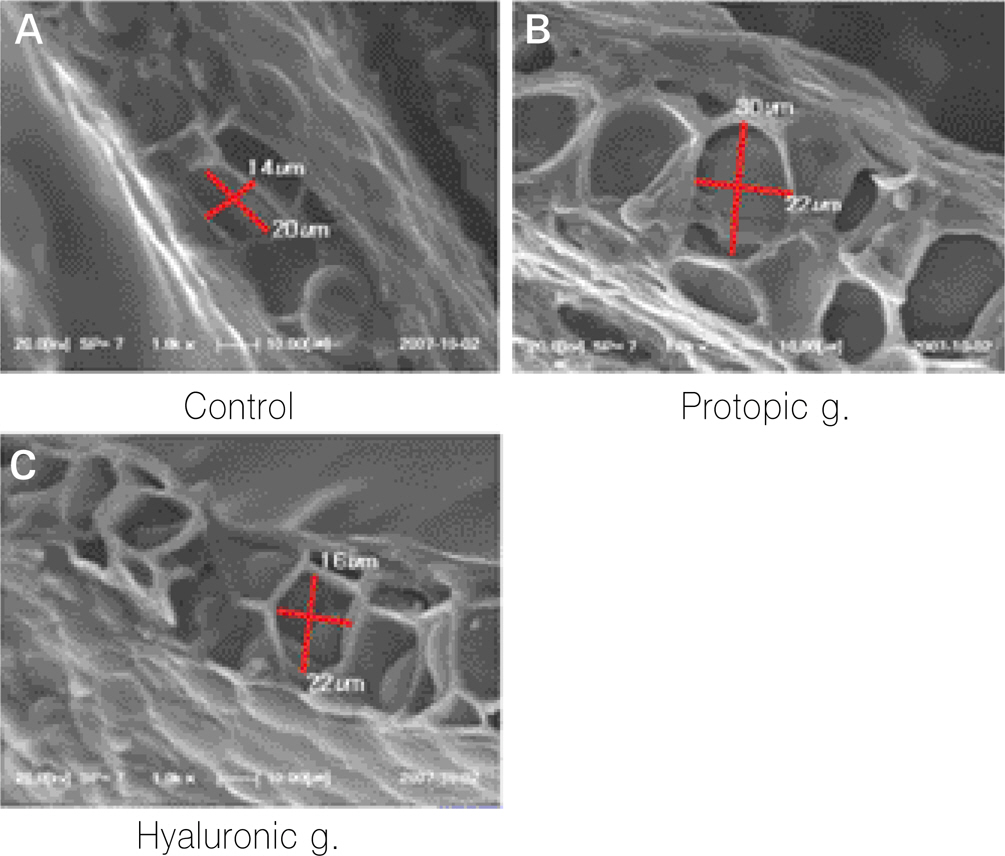J Korean Assoc Oral Maxillofac Surg.
2010 Feb;36(1):16-22. 10.5125/jkaoms.2010.36.1.16.
The effect of hyaluronic acid on anti-inflammatory action in mouse
- Affiliations
-
- 1Graduate student of Hallym University, College of Medicine, Hallym University, Korea.
- 2Department of Oral and Maxillofacial Surgery, College of Medicine, Hallym University, Korea. junpark@hanafos.com
- 3Department of Prosthodontics, Kangdong Sacred Heart Hospital, College of Medicine, Hallym University, Korea.
- KMID: 1457814
- DOI: http://doi.org/10.5125/jkaoms.2010.36.1.16
Abstract
- PURPOSE
The purpose of this study was not only to evaluate the relative mRNA expression of interleukin-1beta(IL-1beta), cyclooxygenase2 (COX-2) and prostaglandin E2 (PGE2) by RT-PCR analysis but to observe pattern of edema by light microscopic and electron microscope after topical apply of hyaluronic acid in inflammation-guided mouse. MATERIAL AND METHODS: Mice of this study were devided into 4 groups: Control group (no inflammation guided), Positive control (inflammation guided + vaselin apply), Protopic group (inflammation guided + protopic apply), Hyaluronic group (inflammation guided + hyaluronic acid apply).
RESULTS
Hyaluronic group showed less expressions of IL-1beta, COX-2, PGE2 than those of positive control & protopic group. Hyaluronic group revealed a decreased inflammation than positive control & protopic group in Light Microscope. Hyaluronic group appeared decreased edema of ear compare to positive control & protopic group in Elecron Microscope.
CONCLUSION
It was considered that hyaluronic acid has an antiinflammatory effect for intercepting the gene expression of cytokines related to inflammation.
Keyword
MeSH Terms
Figure
Reference
-
References
1. Altman RD, Moskowitz R. A randomized clinical trial of intra-articular sodium hyaluronate in patients with osteoarthritis of the knee: a summary. Am J Orthop (Belle Mead NJ). 1999; 28:3–4.2. Caporossi A, Baiocchi S, Sforzi C, Frezzotti R. Healon GV versus Healon in demanding cataract surgery. J Cataract Refract Surg. 1995; 21:710–3.
Article3. Matsuno H, Yudoh K, Kondo M, Goto M, Kimura T. Bioche-mi-cal effect of intra-articular injections of high molecular weight hyaluronate in rheumatoid arthritis patients. Inflamm Res. 1999; 48:154–9.
Article4. Liguori V, Guillemin C, Pesce GF, Mirimanoff RO, Bernier J. Double-blind, randomized clinical study comparing hyaluronic acid cream to placebo in patients treated with radiotherapy. Radiother Oncol. 1997; 42:155–61.
Article5. Huskisson EC, Donnelly S. Hyaluronic acid in the treatment of osteoarthritis of the knee. Rheumatology (Oxford). 1999; 38:602–7.
Article6. Adams ME, Atkinson MH, Lussier AJ, Schulz JI, Siminovitch KA, Wade JP, et al. The role of viscosupplementation with hylan G-F 20 (Synvisc) in the treatment of osteoarthritis of the knee: a Canadian multicenter trial comparing hylan G-F 20 alone, hylan G-F 20 with non-steroidal anti-inflammatory drugs (NSAIDs) and NSAIDs alone. Osteoarthritis Cartilage. 1995; 3:213–25.
Article7. Kim HJ, Shin CH, Hong J, Choi JH. The effects of hyaluronic acid gel on the healing of oral mucosa. J Korean Assoc Oral Maxillofac Surg. 2007; 33:359–66.8. Rosa DS, Aranha AC, Eduardo Cde P, Aoki A. Esthetictreatment of gingival melanin hyperpigmentation with Er:YAG laser: short-term clinical observations and patient follow-up. J. Periodontol. 2007; Oct. 78(10):2018–25.9. Pradeep AR, Kumar MS, Ramachandraprasad MV, Shikha C. Gingival crevicular fluid levels of neopterin in healthy subjects and in patients with different periodontal diseases. J Periodontol. 2007; 78:1962–7.
Article10. Villa AA. Clinical, biochemical and histopatological correlacion in diabetic patiens with periodontal disease. Rev Fac Cien Med Univ Nac Cordoba. 2006; 63(2S):50–5.11. Vangelisti R, Pagnacco O, Erra C. Hyaluronic acid in the topical treatment of gingival inflammations: preliminary clinical trial. Attualita Terapeutica Int. 1997; 15:2–3.12. Pagnacco A, Vangelisti R, Erra C, Poma A. Double-blind clinical trial vs. placebo of a new sodium-hyaluronate-based gingival gel. Attualita Terapeutica Int. 1997; 15:1–7.13. Rabasseda X. The role of hyaluronic acid in the management of periodontal disease. Drugs Today (Barc). 2000; 36(S):1–20.14. Jentsch H, Pomowski R, Kundt G, Gocke R. Treatment of gingivitis with hyaluronan. J Clin Periodontol. 2003; 30:159–64.
Article15. Pistorius A, Martin M, Willershausen B, Rockmann P. The clinical application of hyaluronic acid in gingivitis therapy. Quintessence Int. 2005; 36:531–8.16. Toole BP, Jackson G, Gross J. Hyaluronate in morphogenesis: inhibition of chondrogenesis in vitro. Proc Natl Acad Sci U S A. 1972; 69:1384–6.
Article17. Meyer K, Palmer JW. The polysaccharide of the vitreous humor. J Biol Chem. 1934; 107:629–34.
Article18. Heldin P, Laurent TC, Heldin CH. Effect of growth factors on hyaluronan synthesis in cultured human fibroblasts. Biochem J. 1989; 258:919–22.
Article19. Ghosh K, Ren XD, Shu XZ, Prestwich GD, Clark RA. Fibronectin functional domains coupled to hyaluronan stimulate adult human dermal fibroblast responses critical for wound healing. Tissue Eng. 2006; 12:601–13.
Article20. Voinchet V, Vasseur P, Kern J. Efficacy and safety of hyaluronic acid in the management of acute wounds. Am J Clin Dermatol. 2006; 7:353–7.
Article21. Nolan A, Baillie C, Badminton J, Rudralingham M, Seymour RA. The efficacy of topical hyaluronic acid in the management of recurrent aphthous ulceration. J Oral Pathol Med. 2006; 35:461–5.
Article22. LeBeouf RD, Gregg R, Weigel PH, Fuller GM. Effects of hyaluronic acid and other glycosaminoglycans on fibrin polymer formation. Biochemistry. 1987; 26:6052–7.
Article23. Wheeler JC, Woods JA, Cox MJ, Cantrell RW, Watkins FH, Edlich RF. Evolution of hydrogel polymers as contact lenses, surface coatings, dressings, and drug delivery systems. J Long Term Eff Med Implants. 1996; 6:207–17.24. Jaffe BM. The role of prostaglandins, thromboxane, and leukotrienes in surgery. Sabiston DC, editor. Textbook of surgery: the biological basis of modern surgical practice. 14th ed.Philadelphia: WB Saunders;1991. p. 465–9.25. Davidson EM, Rae SA, Smith MJ. Leukotriene B4, a mediator of inflammation present in synovial fluid in rheumatoid arthritis. Ann Rheum Dis. 1983; 42:677–9.
Article26. Smith WL, Meade EA, Dewitt DL. Interaction of PGH synthase isozymes-1 and -2 with nonsteroidal anti-inflammatory drugs. Adv Exp Med Biol. 1997; 400A:189–96.
Article
- Full Text Links
- Actions
-
Cited
- CITED
-
- Close
- Share
- Similar articles
-
- Clinical Importance and Application of Hyaluronic Acid
- The Effect of Hyaluronic Acid and Steroid in the Experimental Osteoarthritis
- The Effect of Hyaluronic Acid and Epidermal Growth Factor on Cultured Corneal Epithelial Cells in the Rabbit
- Rheological study of hyaluronic acid derivatives
- The Analgesic Effect of Intraarticular Morphine in Osteoarthritis of Knee





